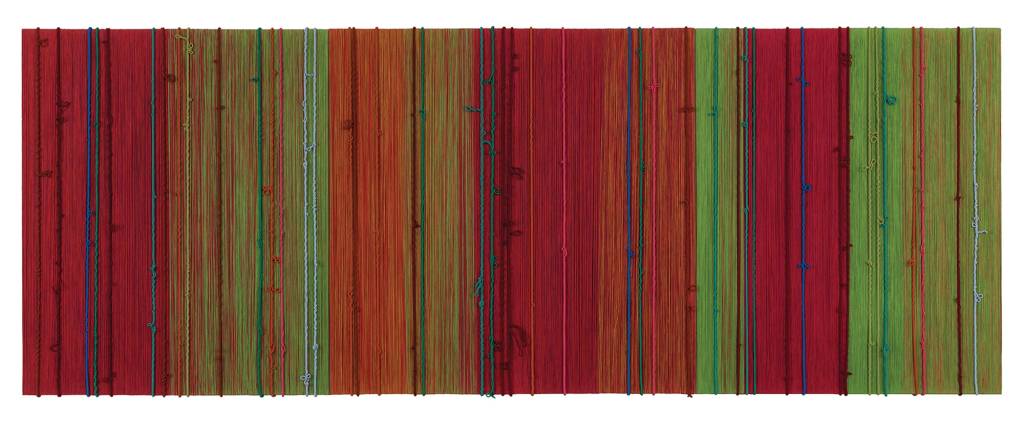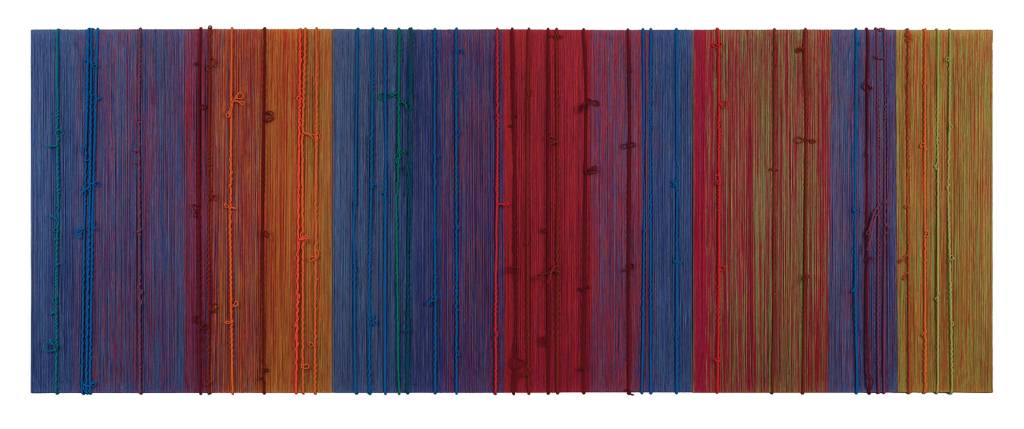Bienvenue to the Carolina Chorus of Good Tidings, Panel 1 and Panel 2
Bienvenue to the Carolina Chorus of Good Tidings, Panel 1

Bienvenue to the Carolina Chorus of Good Tidings, Panel 2

Sheila Hicks’ highly acclaimed textile compositions are found in museum collections and public and private spaces around the world. She has made an immense contribution to the advancement of fiber as a medium for fine art and powerfully ushered it into the realms of painting and sculpture.
Originally from Hastings, Neb., Hicks arrived at Yale University to study art and painting in 1954. For a class on the history of Latin American art, she wrote a paper on textiles from the region that required her to research ancient weaving techniques. As part of this research, Hicks met with a professor’s wife, Anni Albers, an accomplished textile artist who had taught weaving at the Bauhaus and began the weaving program at Black Mountain College in 1934.
After graduating, Hicks received a Fulbright Scholarship to study in Chile. She spent several months traveling through South America and learning about pre-Columbian weaving techniques and practicing them on a small, portable loom. Although she still considered herself to be a painter with a strong interest in architecture, weaving began to assume an ever-larger role in her life, often including ethnographic and cultural references.
Throughout her career, Hicks has explored a wide variety of materials and used them in innovative ways. She has always shifted back and forth between small-scale hand-woven miniatures (which stand alone as finished works and also serve as a method for testing out new ideas) and monumental bas-relief textile friezes and three-dimensional compositions.
Since the first solo exhibition of her weavings in 1961 in Mexico City, her work has been exhibited frequently in major museums and galleries around the world. The Museum of Modern Art, N.Y., was the first institution to purchase one of her weavings. Today, her textiles are in the permanent collections of museums throughout the world.
In the 1960s, Hicks began collaborating with leading international architects and corporations to design site-specific monumental fiber sculptures that are integrated into the architectural spaces they inhabit. Among these have been The Ford Foundation (1967, recreated in 2013 – 2014); Air France for its first fleet of Boeing 747 jets (1969−77); King Saud University, Riyadh, Saudi Arabia (1983−86); the Fuji City Cultural Center, Japan (1992−93); Target Corporation headquarters, Minneapolis (2003; redesigned and donated to the Mint Museum, Charlotte in 2011); and The Duke Endowment, 2015.
As part of her lifelong exploration of new materials, Hicks invited Glen Raven Corporation, the manufacturer of Sunbrella textiles headquartered in Alamance County, N.C., to work with her on an unspecified installation in late 2013. The piece turned out to be Hicks’ monumental sculptural installation for the 2014 Whitney Biennial in New York.
Glen Raven began manufacturing cotton awning fabrics in 1908 and Sunbrella fiber is the result of a decades-long research and development effort to create a longer-lasting awning. Over time, applications for Sunbrella evolved to include fabric for decorative upholstery and accessories — which meant the coloration, texture and fabrication of the yarn, cords, and fabric became increasingly important factors. This development led to the collaboration between Sunbrella and Sheila Hicks.
Hicks has said that “innovation and color are (her) primary concerns,” and the exploration of new technologies through her partnership with Glen Raven is a perfect illustration of this. Sunbrella textiles are made from pigmented acrylic fibers. The pigment is introduced into a liquid acrylic base and the solution is forced through a spinneret that extrudes long, thin fibers, which are spun into threads and twisted into yarn and cords of varying diameters. In contrast to more traditional fiber material, such as cotton, wool, linen or silk, Sunbrella fibers are not dyed; they are thoroughly imbued with pigment. This process results in the brilliance of color and the technical properties — resistance to fading when exposed to UV radiation and to mildew — that characterize Sunbrella materials.
In its collaboration with Hicks, Sunbrella manufactures unique dyes, threads, yarn and cords in intensely saturated hues according to her specifications. Hicks’ first work of art using Sunbrella fiber, the vividly colorful 18-foot-tall sculpture for the 2014 Whitney Biennial, Pillar of Inquiry/Supple Column, was heralded in one review as “a knockout Sheila Hicks tower that was, hands down, the best work in the show.”
Since then, Hicks has created several other works using Sunbrella fiber, including pieces in her year-long rotating installation for the Palais de Tokyo in Paris in 2014 and the monumental L’Atterrissage of the same year, which the Louis Vuitton Foundation purchased for its new headquarters.
For The Duke Endowment, Hicks created two site-specific friezes, each composed of three panels. These radiant bas-relief sculptures have a base of Sunbrella canvas, wrapped with linen and surmounted with calligraphic relief elements made of manipulated Sunbrella cords. When imagining what she might create for the Endowment, the artist recalled that lush vegetation flanked the room in which the friezes would hang.
She envisioned creating panels that would suggest a continuation of the garden by opening up the walls as if they were windows — the red and green panels evoke a colorful garden in full sunlight, while the blue and purple panels offer the impression of a garden at dawn, dusk, or on a cloudy day. Hicks described her selection of the colors as seeming predestined. While winding the panels with linen in her Paris studio, where she is surrounded by thread, yarn and rope in myriad colors, she felt as if each hue led to the next as if it were calling its successor.
Hicks designed the texture of the Endowment panels to evoke the sensation one would have when passing through a forest with light entering from both sides. The vertical lines drawn with linen yarn and Sunbrella cord suggest the abbreviated forms of trees and other vegetation in a very deep space, as if viewed while driving through a forested area. The panels offer the sublime evocation of a forest that will change slightly according to the season and time of day.
It seems entirely fitting that Hicks’ luminous, richly textural friezes would be at home in the building that houses the philanthropic legacy of the man whose investment genius fueled the development of the textile industry in the Carolinas. Mr. Duke’s spirit of innovation is echoed in Hicks’ advancement of fiber as a medium for avant-garde sculpture and in the technological invention of Glen Raven’s scientifically-engineered fiber.
Artist Spotlight
Sheila Hicks This short video features a behind-the-scenes glimpse of Sheila Hicks as she brings the energy and vibrancy of her highly acclaimed textile compositions to The Duke Endowment.
